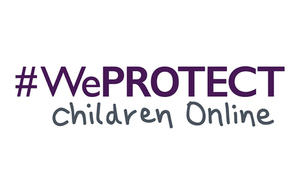Tech industry fights online child sexual exploitation
World-leading technology companies pledge to eliminate online child sexual exploitation

WePROTECT logo
The world’s biggest search engine, social media and software firms have today (Tuesday 17 November) pledged to continue fighting the abuse of the internet for online child sexual exploitation by developing new technology, tools and expertise.
Technology companies signing up to this ‘Statement of Action’ include Google, Microsoft, Facebook, Twitter, Yahoo and Tencent. These companies will each make a significant contribution to efforts to tackle online child sexual exploitation (CSE).
These commitments have been made at the WePROTECT summit in Abu Dhabi, UAE, and build on the industry promise, which was made at last year’s summit, to continue working with the Internet Watch Foundation to receive the digital fingerprints of indecent images of children to enable removal.
WePROTECT was originally launched by the UK Prime Minister in London last year. The aim is to bring together governments, NGOs, industry and civil society organisations to pledge global action to eliminate online CSE.
Home Secretary Theresa May said:
The fight against online child sexual exploitation is not for government alone and that is why the commitments made by industry today are key to eliminating this global and complex crime.
By developing innovative technology such as the Child Abuse Image Database to transform the way police officers tackle this crime, and supporting the work of industry and the Internet Watch Foundation, WePROTECT – governments, NGOs, industry and law enforcement agencies – is securing a safer future for children around the world.
Minister for Internet Safety and Security Baroness Joanna Shields said:
I believe the partnership between governments and digital innovators is absolutely vital to staying ahead of this vile crime.
I commend the industry for taking hashes – the digital fingerprints of child sexual abuse images – from the Internet Watch Foundation to enable the detection and removal of indecent images of children.
This work, and the commitments set out today by the industry, complements the action we have undertaken with law enforcement agencies to transform the way officers tackle online child sexual exploitation by introducing new technology through the Child Abuse Image Database.
This partnership between governments, industry and law enforcement agencies continues to go from strength to strength, which is imperative if we are to eradicate this crime.
Further achievements and commitments by industry include:
- the Googler in Residence programme, which has developed a tool to review images, a URL checker, web crawler and an image blocker to increase capacity and expertise at the UK’s Internet Watch Foundation
- Yahoo has successfully piloted the use of a Google tool which identifies indecent videos of children
- Microsoft will enable more organisations to find indecent images of children using PhotoDNA by making the hashing technology available in the cloud for qualified companies
- Microsoft will also develop a content moderation starter kit to help other companies develop resilience and wellness in the teams who remove indecent images of children from their internet services
- Google is to work in partnership with the wider tech community to launch a ‘safety hub’ next year – through the hub, Google and others will share technology used in the fight against online CSE with NGOs and industry; organisations will be able to use Google technology in order to use it in their own work to tackle online CSE
- Facebook is to rollout their ‘AMBER Alert’ initiative in more countries around the world, which will see civil society organisations, governments and industry working together to tackle the issue of missing children
- Microsoft and tech companies continue to support innovation through Thorn labs in California, USA, to build innovative solutions to fight CSE through financial donations, expertise, guidance and engineering support
- Facebook teams dedicated to child safety will be offering a series of training for smaller and/or newer members of industry on how to successfully implement PhotoDNA – technology that aids in finding and removing images of child sexual abuse from the Internet.
- a dedicated team of Facebook engineers will be assisting in a much needed technology upgrade for the National Center for Missing and Exploited Children (NCMEC) in the USA, to help them manage the anticipated increase in the number of reports resulting from the growing global collaboration to tackle online CSE